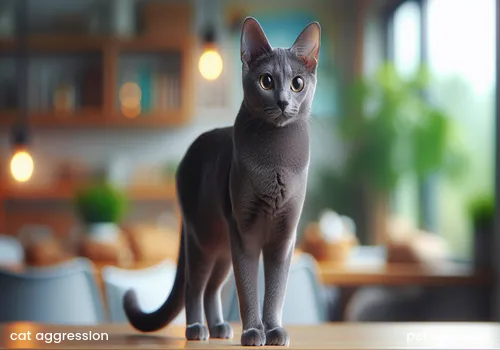Cats Get More Aggressive the More They Are Raised_How to Improve the Problem of Cats’ Worsening Temper
Cats are beloved members of many families, but if you find the “master” at home becoming increasingly bad-tempered or even showing aggressive behavior, it doesn’t mean the cat has “turned bad,” but that they are sending a distress signal in this way. Understanding the reasons behind worsening cat temper and taking the right improvement measures can help them regain calm, and also cause fewer scratches and less "cat teeth baptism" for the owners.

Worsening cat temper—what might they be "complaining" about?
Cat aggression usually doesn’t happen without reason; their "worsening temper" often hides physical or psychological discomfort. The American Society for the Prevention of Cruelty to Animals (ASPCA) points out that aggression is the second most common behavioral problem in cats.
1. Physical discomfort or pain
This is the most common and easily overlooked reason for a cat’s worsening temper. Cats are natural masters at hiding pain; even when uncomfortable, they try to conceal it. This instinct comes from their wild survival skills—showing weakness can attract predators or bullying from other cats.
- Common ailments: arthritis, dental problems, injuries, infections, hyperthyroidism, urinary tract diseases (such as cystitis, urethral stones), even tumors, can all cause pain or discomfort, leading to irritability or increased aggression in cats.
- How to notice: If a cat suddenly hisses, bites, or scratches when touching a specific area, or decreases activity, refuses to jump, loses appetite, shows abnormal elimination (such as urinating or defecating outside the litter box), or curls up with abnormal posture (like the "brooding hen" squat), these may be signals of pain.
2. Fear and anxiety
When cats feel scared, insecure, or unable to escape, they might use defensive attacks to protect themselves. This is similar to how humans instinctively fight back when backed into a corner.
- Common causes:
- Insufficient socialization: If kittens lack good socialization with humans or other animals during their critical 3-7 week period, they may fear strangers or new environments later, showing aggression.
- Environmental changes: Moving house, new household members (new pets, babies, guests), rearranged furniture, new smells in the air (like perfume, air fresheners), or loud noises (fireworks, firecrackers) can stress and unsettle cats.
- Negative experiences: Cats who have experienced rough treatment (such as physical punishment or scolding) or frightening events associate these negative memories with certain human actions; even gentle petting may be seen as a threat, triggering defensive aggression.
3. Play aggression and hunting instinct
Many cats’ “attacks” are actually expressions of their hunting nature, especially when overly excited during play.
- Common behavior: Cats may ambush and pounce suddenly on your hands or feet, biting and scratching, then quickly running away. This is especially common with kittens learning hunting skills by playing with siblings. If owners use hands or feet to tease cats from a young age without proper guidance, cats may mistake the hands and feet for "prey" and reinforce this inappropriate behavior.
- Overexcitement: Sometimes cats get too excited playing or frustrated by unmet hunting drives (like seeing birds outside but unable to catch them), and transfer this excitement or frustration onto people or objects nearby. This is called "redirected aggression."
4. Territory and resource competition
Cats have a strong territorial instinct. When they feel their territory is invaded or important resources (such as food, water bowls, litter boxes, cat trees, or the owner's attention) are threatened, they may become aggressive.
- Common scenarios: This is most common when a new cat or pet is introduced at home, sometimes targeting specific family members or guests. Intact male cats especially may fight over territory and mating purposes.
5. Petting-induced aggression
Some cats suddenly “turn on” when being petted—enjoying it one moment and then clawing or biting the next. This is called "petting-induced aggression."
- Reasons: It may be due to low tolerance for petting, overly long or strong petting, or touching areas they dislike (such as the belly or base of the tail). Cats send “enough” signals through body language like tail flicking and ears laid back. If owners don’t stop in time, attacks can occur.
6. Maternal aggression and estrus aggression
Mother cats become fiercely aggressive when protecting their kittens, viewing anyone approaching the young as a threat; this is “maternal aggression.” Also, cats in heat (especially unspayed ones) have unstable moods and increased aggression due to hormonal effects.
How to improve problems caused by a worsening cat temper?
Improving a cat’s aggressive behavior requires patience and the right methods. Never use violence to counter aggression as punishment only worsens fear, anxiety, and damages the human-cat relationship.
Step 1: Eliminate health problems (priority and crucial)
- Take the cat to the vet: If a cat’s temper suddenly worsens, first take it for a thorough veterinary examination. This is key to exclude underlying illness, pain, or other physical causes of aggression. Vets may conduct X-rays, blood tests, etc., to ensure the cat is not exhibiting aggression due to physical discomfort.
Step 2: Behavioral intervention and environmental optimization
Once health issues are ruled out, work on behavior and environment with targeted approaches.
- Identify and avoid triggers: Observe carefully when your cat shows aggression (for example, certain petting styles, the arrival of strangers, specific sounds), then try to avoid or minimize those triggers.
- Provide security and “private space”:
- Hidden shelter: Cats need a safe, hidden place to hide to feel control and security. Offer cat beds, cardboard boxes, high cat trees, or the tops of cabinets.
- Adequate resources: Ensure enough food, water bowls, litter boxes, and scratching posts in the home, with at least one more than the number of cats, and spread out to avoid competition, especially in multi-cat households.
- Vertical space: Cats love heights; provide cat trees, perches, or high resting spots so they can observe surroundings from a safe distance, reducing anxiety.
- Correct play methods (for play aggression):
- Use toys: Never use your hands or feet to tease your cat directly. Use teaser wands, laser pointers, plush toys, etc., to let cats redirect their hunting instinct onto toys. Keep toys at a distance from your body to avoid accidental scratches or bites.
- Increase exercise: Engage in 2-3 interactive sessions daily, each lasting 10-15 minutes, to burn cat energy and satisfy hunting needs. Especially during dawn and dusk, when cats are more active.
- Stop promptly: If your cat becomes too rough during play, biting or scratching, immediately stop playing and walk away. Ignore the cat for 5-10 minutes to teach them these behaviors end the game, reducing reinforcement of bad behavior.
- Build positive associations (for fear and petting aggression):
- Gentle socialization: Treat cats gently and patiently. For shy or previously traumatized cats, don’t force interaction. Use treats or favorite toys at a safe distance to build trust gradually.
- Understand cat body language: Learn to recognize signs of discomfort or warning such as tail flicking, ears laid back, dilated pupils, stiff body, hissing. Stop petting or interaction immediately when these appear and give space.
- Gradual approach: When petting, start with favored spots like the head or chin for short periods. Reward cats when they show enjoyment or relaxation. Slowly expand time and areas pet, always respecting cat’s tolerance.
- Socialization training (for kittens or poorly socialized cats):
- Early intervention: For kittens, during the 3-12 week critical socialization period, expose them to different people, sounds, smells, and environments, and encourage appropriate play with siblings or gentle adult cats to learn social boundaries.
- Gradual exposure: For adult cats, use barriers like screen doors or glass to let them get used to new environments or new members slowly before increasing direct contact time.
- Stress management:
- Stable routine: Maintain consistent daily schedules for feeding, playtime, etc. Cats value routine and stability highly.
- Environmental enrichment: Provide sufficient toys, scratching posts, cat trees, and change toys regularly to avoid boredom or pent-up energy that can cause destructive or aggressive behavior.
- Assisting products: Consider using feline pheromone diffusers or sprays that mimic reassuring facial pheromones to alleviate anxiety and stress. Cat grass or catnip can also help relax cats.
Frequently Asked Questions
Q1: What does hissing and puffed fur mean in cats?
A1: Hissing and puffed fur (raised hair) are usually signals of fear, defense, or warning. It means the cat feels threatened and tries to look larger and more intimidating, telling you “Don’t come closer, I’m ready to fight back!”
Q2: Does a cat biting randomly mean revenge?
A2: Cats do not have the complex “revenge” psychology that humans have. Their aggression usually comes from fear, stress, pain, excessive excitement in play, territorial defense, or unmet needs. Rather than revenge, it is their most direct way to express feelings or seek help.
Q3: What to do if cats keep fighting in a multi-cat household?
A3: Fighting among multiple cats is common over territory and resources. You can try these methods: ensure each cat has separate food bowls, water bowls, litter boxes, and resting areas (number of litter boxes should be number of cats +1, and placed separately); increase vertical space like cat trees and perches to give them their own “high ground”; use pheromones, shared play times (using toys, not hands or feet), and reward systems to build positive connections; intact males fight more often and should be neutered.
Q4: Should I hit the cat if it suddenly bites me?
A4: No, you should not hit the cat. Physical punishment is ineffective and worsens fear, stress, and aggression, making the cat more afraid of humans. The correct action is to stop interaction immediately, walk away, and give the cat time to calm down, teaching that aggressive behavior ends play or interaction. Afterwards, try redirecting to toys rather than direct contact.
Conclusion
A worsening cat temper doesn’t mean cats are intentionally “being bad,” but that they are expressing emotions and communicating in their unique way. As owners, we must learn to "read" these signals and guide improvement with great patience and scientific methods. From taking cats to the vet to rule out physical problems, to optimizing living environments and adjusting interactions, every step embodies love and responsibility for the “master.” When your cat purrs contentedly by your side again, that warmth and trust are the best rewards.
References
- What to do if a cat is aggressive? — Cat behavior problems and coping strategies (Part 3) - Douban
- Feline Behavior Problems: Aggression | Cornell University College of Veterinary Medicine
- Aggression in Cats | ASPCA
- What to do with a highly aggressive cat? Don’t throw it away, it can still be rescued - Tencent News
- Cats often aggressive? These reasons may cause it; learning them can help cats get through crises - NetEase
- Is your cat always fighting or biting? Break down 14 types of aggressive behavior! - NetEase
- Cat suddenly turns aggressive? A discussion on "play aggression behavior" causes and correction - SofyDOG
- Causes of Sudden Aggression in Cats - PetMD
- Cat Aggression: Fighting, Biting, and Attacking - PetMD
- Aggression in Cats: Understanding the Causes and Solutions - Just Cats Clinic
- How to judge cat aggression problems - Cat Talk Society
- 12 types of cat aggressive behavior all at once! - Cat Royalty
- 5 socialization trainings kittens must do! Make your kitten affectionate and well-behaved
- Cat fear aggression behavior - Datun Veterinary Behavior Clinic
- How to recognize cats under stress - Royal Pet Foods
- Aggressive behavior caused by fear and pain in cats - Pet 23 Things
- 【Beginner Cat Care】How to train cat socialization and develop cat personality? - Diaries - Douban
- Common 19 stressors for cats, how many have you violated? - Tencent News
- Play Aggression (Cats) - San Francisco SPCA
- Signs your cat is stressed? Test if your cat needs stress relief? - NetEase
- Cause Behind an Aggressive Cat - NaturVet®
- Stop feline aggression to keep cats from fighting | Humane World for Animals
- How Medical Conditions Impact Cat Behavior - Tails & Tips
- Must see! 6 major symptoms of cat stress and how to relieve it - Pet Doctor
- "Cat Fear Aggression: How to Help Your Cat Overcome Fear and Aggression" - Fanggezi
- What to do about cat stress? 6 common symptoms + 3 stress relief tips - Cat Royalty
- Factsheet – feline aggression - Cat Protection Society of NSW
- Do you understand cat aggressive behavior?
- Cat socialization training | 9 nanny-level methods to raise a well-behaved kitten. Who said only dogs can shake hands - SMZDM
- What to do if cats fight each other?
- Reasons for cats’ aggressive behavior toward humans - Breeding Encyclopedia - China Agriculture Press
- Why do cats have play aggression? | PetTalk Pet Health Talk
- 7 signs cats are suffering pain, do you know them? | Drowsiness | Painkiller | Symptoms - NetEase
- Teaching kittens social skills - Royal Canin
- Why do cats attack? How to handle "challenging" cats? - Sina
- Socialization training, key process to make cats clingy - NetEase
- Understanding the importance of cats
- 【Cat Care】Cat pain and discomfort? Vet tells you 7 signs not to ignore - Reed Cat Litter
- Cat aggression - Redirected aggression problem: r/CatTraining - Reddit



